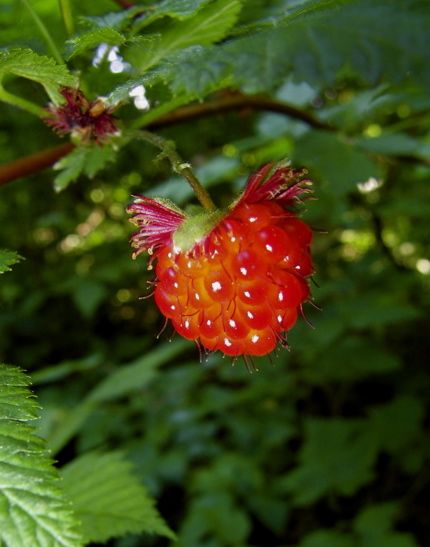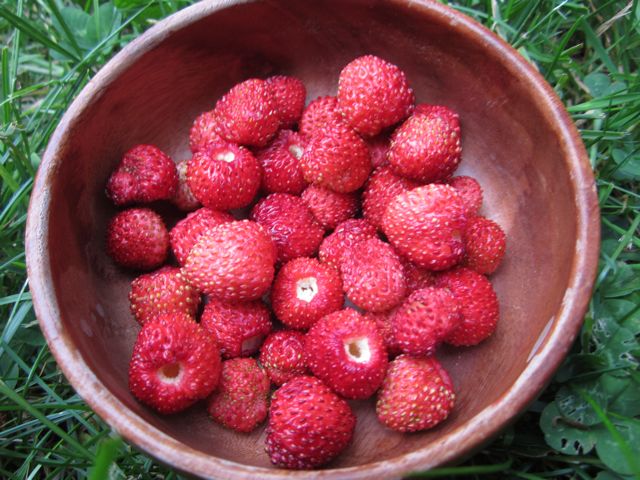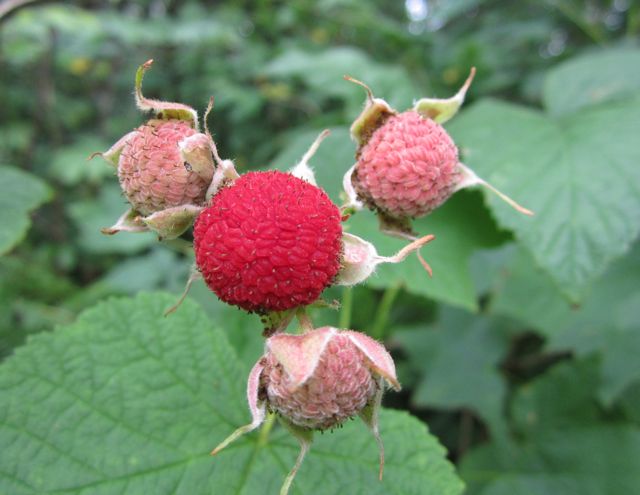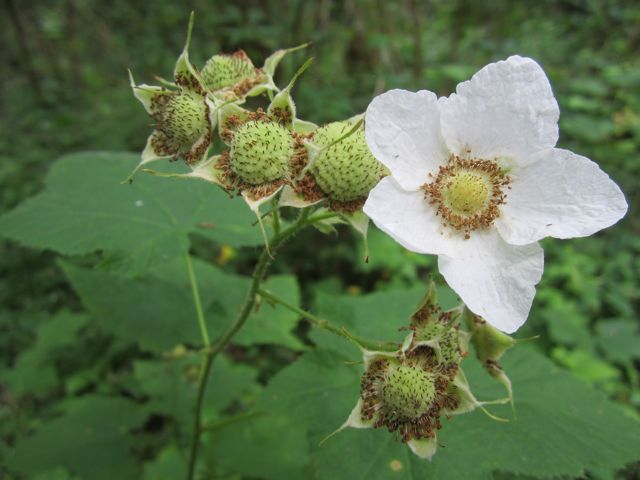At last it has arrived – the moment we wait and wait for. Summer – warm and liberating. And nothing epitomizes summer like berries. First jewels of salmonberry lighting up the forest, red huckleberry making my lips pucker, the intoxicating smell of ripe strawberries, savoring the crunchy sweetness of thimbleberries, blackberries dripping off the vine. Berry stained fingers and berry stained lips. This is the gift of summer – and I celebrate its juiciness.
I am busy packing away this sweetness. I freeze strawberries and raspberries to put in smoothies and oatmeal. Bake blackberry pies weekly. Hit the trail as often as possible to nibble on red huckleberries. Dry berry leaves for tea throughout the year. Harvest salal berries to make fruit leather. Can raspberry rosehip jam for holiday gifts. This ensures that even in the cold days of winter we can relish the flavors and smells of the summer sun.

Huckleberry
Vaccinium spp.
What could be more rewarding than wandering through the woods and finding a bush covered in ripe huckleberries? In the Northwest, there are more than 20 species of this tasty berry, which range from the coast to the high mountains. Huckleberries come in many sizes. Dwarf wartelberry is a mere six inches tall and is covered in tiny red berries that would satisfy a mouse, while the bigger mountain blueberries and huckleberries are large enough for bear to gorge on and actually get full. Berry colors range from orangish-red to purple to deep blue-black. The difference between huckleberries and blueberries is that huckleberries have a stronger flavor, but botanically they are the same genus.
Huckleberries are one of the most important traditional foods and also one of the healthiest. They may be one of the reasons that many Native elders lived to be over 100 years old. They are considered an anti-aging food and are even being made into dietary supplements. Antioxidants in the plant protect body tissue from “free radicals” in cells that cause damage. They prevent inflammation and increase tissue strength.
Red Huckleberry Evergreen Huckleberry
Huckleberry for Diabetics – Huckleberries are one of the only fruits that do not raise your blood sugar. All fruits have natural sugars in them, but huckleberries have a compound that actually lowers blood sugar, so the net blood sugar effect is zero. They are high in antioxidants, which help protect the body from the effects of high blood sugar including diabetic retinopathies, kidney damage, and poor tissue healing.
Huckleberries and blueberries contain arbutin, a plant compound that helps to fight the bacteria that usually causes urinary tract and bladder infections. The berry juice or the leaf tea is used as a preventative and a treatment.
Salmonberry
Rubus spectabilis
Salmonberries are some of the earliest berries of the spring. Their bright pink flowers add a first splash of color to the forest after winter. In April through June succulent orange to ruby colored berries appear. Flavor can vary according to where plants grow, so taste test some to find the bushes that are most delicious. Salmonberry forms dense thickets in generally wet forested areas. It grows as high as nine feet tall with brown stems which are covered in thorns and leaves resembling the raspberry plant.
Salmonberries are especially juicy and do not dry or preserve well. They are usually eaten fresh, although salmonberry preserves are popular in Alaska. Salmonberry leaf and bark are astringent like other rose family plants. They are traditionally used for wounds, burns, stomach problems, etc. Only use the leaves when they are fresh or totally dried because they are mildly toxic when they are wilted.
Salmonberries are said to carry ecological knowledge. When the berries are abundant in early spring many Salish People say that this is a sign that it will be a good salmon run. That makes good sense because salmonberry is a water-loving plant that thrives along streamsides. Salmon need strong running streams to make their journey up to the place of their birth.
Thimbleberry
Rubus parviflorus
These bright red berries are a symbol of summer’s delicacies. The seeds are tiny and have a little crunch that is pleasing to the senses. The berries are delicious fresh, and because they are seedy and less water-laden, they dry well as fruit leather. Large soft maple-like leaves give this plant another common name: “toilet paper plant.” You can imagine how useful it is when you are far from the bathroom. Thimbleberry flowers are large and white, resembling a wild rose.
Thimbleberry is a special herb for women’s health. The astringent qualities of the leaves are said to help tone the uterus in a similar way to raspberry leaf. The roots and bark are also astringent.
Quileute tribal member Edwin Poulin remembers how important thimbleberry is to his people. They are the most prized fruit out along the coast where he grew up. His grandmother told stories about drying the berries in cakes, then wrapping them in leaves and storing them along the river. They would remove large rocks from the sides of the riverbed, place the berries in this “cave,” then return the rocks. This cache system kept the berries cool and fresh.
Trailing Wild Blackberry
Wild blackberries (Rubus ursinus) are low-growing plants with long running stems that act like trip wires in the woods. I have often found them by accidentally catching one on my foot. Blackberries are notorious for being heavily armored with thorns that point toward the center of the bush so that you get caught on them when you try to retreat. Blackberries create a ground cover in the woods or in clearings. Male and female blackberry flowers grow on different plants. They are white with five long petals. Only the female plants produce the juicy delicious berries. Sometimes you will see a whole area covered by healthy looking blackberry runners and not a single berry. This is probably a male plant.
Wild Blackberries have 10 times the flavor of the non-native Himalayan blackberries that are now taking over so many landscapes here in the northwest. It is said that the naturalist Audubon introduced the Himalayan blackberry to create habitat for small songbirds. How hard it is for people to understand the complexity and interrelatedness of our ecosystems, and what can happen when a non-native plant or animal disrupts them.
Blackberry leaf is an astringent medicine, and can be made into a pleasant, rose-tasting tea. It has traditionally been used for stomach aches, burns, wounds, diarrhea and sore throats. Gather the leaves in spring through winter and dry in paper bags or hang on hooks in a warm place with good airflow. You can also place the leaves on a cookie sheet in a low-temperature oven until they are crackly, then place the leaves in a large flat-bottom pan and mash them up with a potato masher. This will prevent you from hurting your hands when you try to break them apart for tea. Use one small handful per cup and drink several cups a day for specific medicine or as a general tonic for health. The berries are high in vitamin C and natural sugars.
My mother would make this bargain when we were kids: if we gathered enough berries for pie, she would bake it. It did not take long to accomplish this task and the kitchen was often brimming with the aroma of hot berry pie. For me, it is the smell of August – a time of hot sun, swimming and the carefree days of my youth. You can get creative with recipes and make blackberry lemonade or blackberry sauce by mashing the berries and pressing them through cloth or a fine strainer to remove the seeds.
Wild food forager Robert Henderson gives some advice in harvesting blackberries in his book The Neighborhood Forager. He says to gather with a pail or container with rigid sides to prevent the berries from getting mushy and to prevent the thorns from grabbing and tearing a plastic bag. Try not to wear loosely woven clothes for the same reason. I learned this lesson after a particularly thorny patch ruined my favorite sweater.
Wild Strawberry
Fragaria spp.
Strawberries are a lot of work to gather, but the results are always worth it. One of these little berries the size of your smallest digit on your pinky finger has more flavor than the huge hybridized berries they sell in the market now. I have heard old timers voice their concerns about how the strawberries just do not taste like they used to. “They bred the flavor right out of them!” one elder said. In this time where seemingly everyone wants quantity over quality, these little strawberries remind us that some of the most sensational flavors can only be found in the wild.
Many people simply eat strawberries fresh in the field because they are difficult to transport (and difficult to pass up in the moment). Because of their high water content, they do not dry well. Makah women and children would traditionally go to the berry fields and have a picnic, eating them on the spot. The Quinault ate them as a party food. Strawberries teach us to take in the fruits of the moment.
Two common types of wild strawberries in our area include woodland strawberry (Fragaria vesca) and Coastal strawberry (Fragaria chiloensis). Each is well-named for its’ preferred growing region, although you can grow either one of these in your garden as a beautiful ground cover. Strawberries seem to taste better when they are growing in the sun. They spread quickly, with runners forming a carpet over the ground.
Like many rose family plants, strawberry leaves are astringent. They are helpful for ailments including diarrhea, burns and upset stomach, as well as skin, mouth or throat inflammation. Strawberry leaves are high in vitamin C and make a tasty tea that is reminiscent of wild berries. They can be harvested from spring through summer. Simply pick the leaves and lay them in a basket or paper bags. Turn them over every day so they get good ventilation. When they are completely dry, place them in a glass jar or plastic bag. They will stay potent about one year.












